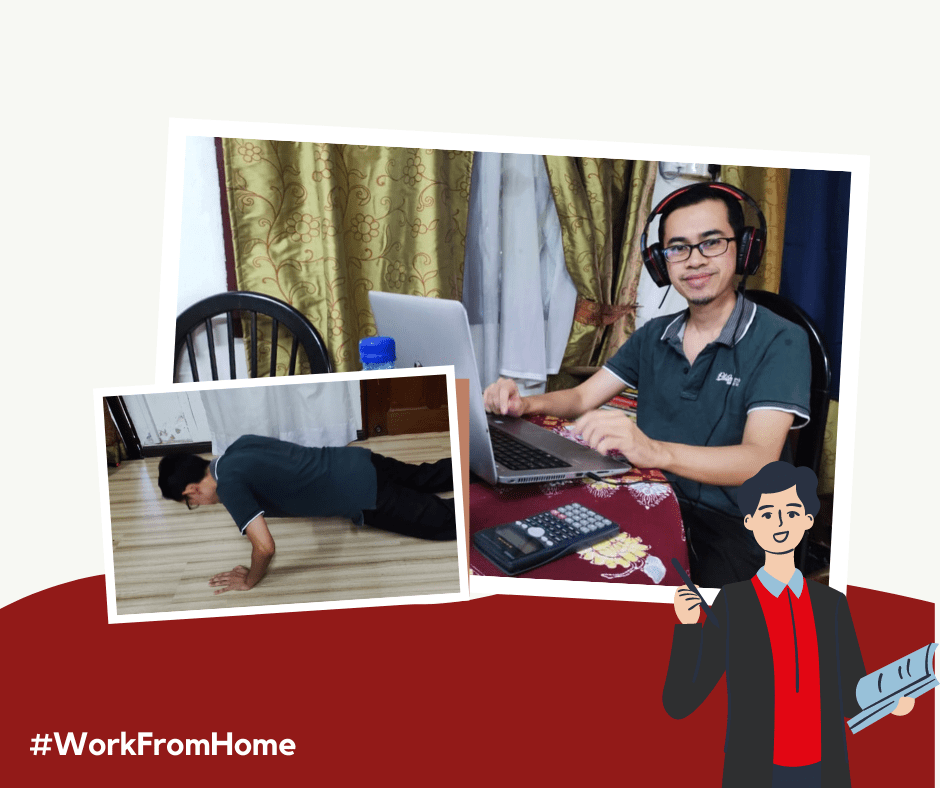Lecturers, who are the frontline workers for university and college students, have experienced a year and a half like no other. It is during this time that we are witnessing how adaptable and resilient educators continue to be to support students under their care.

Dr Yip Pick Schen, a lecturer from INTI International College Penang’s Centre for Australian Degree Programs, will usually have a little rejuvenation break by spending time with her baby girl after office hours.
Four lecturers from INTI International College Penang talk about the change to remote instruction and how they have been coping working from home during the coronavirus outbreak. Flexible working schedules, more family time at home, and cost savings on commuting have been a blessing for many.
“Zero amount of time is spent on commuting from home to campus, which would typically take 45 minutes to an hour on a good day. Online classes allow me to focus on getting into the ‘mind frame’ for class, instead of exhausting myself getting to a physical classroom,” said Archanaa Maniappen, a lecturer from the Centre for Language and Mata Pelajaran Umum (MPU).
Dr Yip Pick Schen, a lecturer from the Centre for Australian Degree Programs, shared that her favourite part of moving classes online has provided her the flexibility of designing “in-class” activities.
“Using different approaches such as breaking students into groups for discussion, making a quick poll to assess student understanding of the materials, and sharing a virtual whiteboard to gather students’ viewpoints are some of the most effective virtual tools for idea synthesis. Surprisingly, my students love it and indeed all these activities have increased student engagement as compared to traditional face-to-face classes,” she said.

Dr Beh Boon Chun, a lecturer from INTI International College Penang’s Centre of Excellence for Pre-University Studies, loves spending time with his nieces and nephew to recharge himself.
For Dr Solahuddin Yusuf Fadhlullah, a lecturer from the School of Engineering and Technology, said there are many advantages from shifting classes online because technology solves a lot of problems in many ways.
“My three favourite things for having classes online are that I no longer need to raise my voice as students can adjust their own system volume. Second, I find it convenient to deliver part of the lecture that requires video clips and simulation demonstration. Third, I can dress casually,” he shared.
Meanwhile, Dr Beh Boon Chun a lecturer from the Centre of Excellence for Pre-University Studies noted that he can now conduct class anywhere and anytime. To him, virtual learning offers a good substitute to classroom learning in the time of emergency.
The Challenges of Remote Teaching
Though most educators around the world are adjusting to remote instruction, there are some teaching and learning elements that cannot be replicated at home. It is undeniable that both students and lecturers are continuously searching for new tools and paths to face challenges they have not faced before.
While Archanaa is proud of the seamless transition of her language courses online, she still faced challenges.
“Redesigning activities to suit online participation, revamping teaching material to allow students to participate actively during online lessons, providing clear instructions, and building a student’s comfort and confidence to respond while being anonymous have been my biggest challenges,” she said.

Archanaa Maniappen, a lecturer from Centre for Language & MPU, INTI International College Penang, enjoys reading and watching stand up comedies as it helps her to relax.
According to Dr Beh, the transition required many hours of work and a great deal of patience.
No doubt, students majoring in academic fields such as languages, history and philosophy may gain sufficient theoretical knowledge via online teaching and learning, with the fields of science, engineering, and vocational subjects require lab and practical work.
“The biggest challenge that I face is converting my face-to-face practical sessions into virtual labs. Some preparation work includes exploring appropriate simulation from website, filtering the simulation so that it can suit face-to-face practicals and creating new worksheets for students based on the simulation,” he admitted.
“Initially, it was the effort to migrate all the learning materials online but right now, the main challenge is to ensure the students are able to follow the syllabus. It is a bit different being behind a screen,” said Dr Solahuddin.
To Dr. Yip, her biggest challenge is establishing a presence as an online instructor in a virtual classroom. She strongly believed that there is a significant direct relationship between perceived presence and student engagement.
“There are some strategies to get students to feel my presence. For example, my normal practice prior to the first class is sending a welcome message to students to enhance students’ understanding of the course expectation. Additionally, I will create a WhatsApp group for the students to chat informally and improve two-way communication,” she said.
On another note, after months of campus closure, Dr Yip also yearns for in-person interaction with her students and misses the energy of being in a physical classroom environment.
“I miss the moments of having student interactions, covering both student-lecturer as well as student-student interactions. The mesmerizing facial expressions of students during physical class is something that I kind of cherish. Of course, such expressions also indirectly indicate the student’s level of comprehension of the delivered lecture.” she added.
The truth is, teaching online is not easy, but it can be done and can be rewarding.
Paradigm Shift
Dr Solahuddin said his students are now more eager to continue with the new teach model despite an initial hesitation towards online classes.

Dr Solahuddin Yusuf Fadhlullah, a lecturer from the School of Engineering and Technology, INTI International college Penang, enjoys reading the news and doing light exercises daily to freshen the mind.
“The students have adapted well and here is the proof. Exam and assessment results are comparable to pre-covid days with no major drop of marks or failure rates and student ratings remain high.
“INTI started its online learning efforts in 2012 and also introduced the Blackboard Learning Management System (LMS), making the transition to fully online teaching and learning a smooth one,” he said.
Dr Solahuddin’s view is echoed by Dr. Yip. She opined that INTI e-learning champions have also been very supportive towards fellow lecturers during the pandemic.
“They conducted many webinar sessions to encourage us to adapt ourselves to a remote teaching environment, such as how to conduct interactive live class sessions using Blackboard Ultra or WEBEX and ensuring active learning and assessing students’ achievement of the learning outcomes,” she said.
Meanwhile, Archanaa remarked that her colleagues have also been extremely forth coming when it came to testing new and upgraded tools within the LMS.
“They have identified setbacks and provided alternatives and also shared interesting resources that can be used for class,” she said, adding that INTI has been helpful in offering various resources to support their efforts to teach from home.
Working from home may have been tough at first, but it is increasingly accepted by many, and the proof can be seen in the productivity of lecturers during the pandemic. Amidst the challenges, INTI will continue to support the efforts of its lecturers to provide students engaging online learning experiences while they are away from campus.